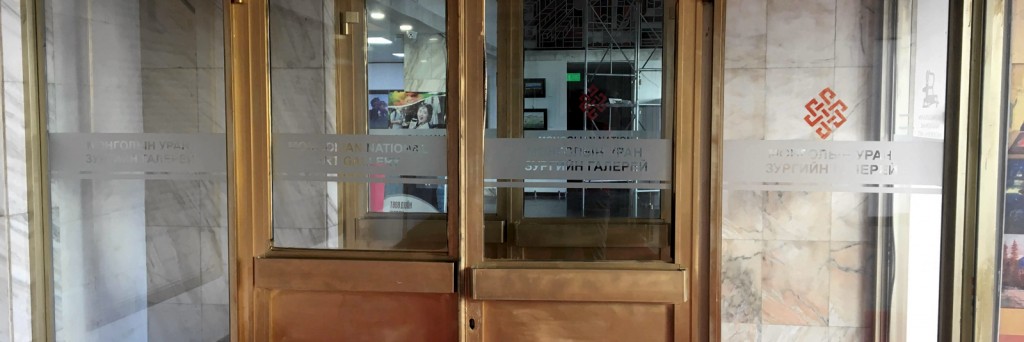
Monday, October 14, 2019
My first venture into Ulaanbaatar. I stepped out the side door of my hotel and literally into the front door of the National Modern Art Gallery of Mongolia. Score!  This museum had been high on my list of cultural places to visit, and here it was, just across the alley! I paid the ₮2,000 entry fee (US$0.75), and climbed the stairs to the gallery, admiring Sereeter Dagvadorj’s 1954 ”Way and Horse Clatter” installation that filled the stairwell.
This museum had been high on my list of cultural places to visit, and here it was, just across the alley! I paid the ₮2,000 entry fee (US$0.75), and climbed the stairs to the gallery, admiring Sereeter Dagvadorj’s 1954 ”Way and Horse Clatter” installation that filled the stairwell.
The first floor featured (I’m guessing since I don’t read Mongolian) a visiting Chinese photographer. Her photography was stunning, but I had come here to view Mongolian art and Mongolian subjects, so on to the second floor.
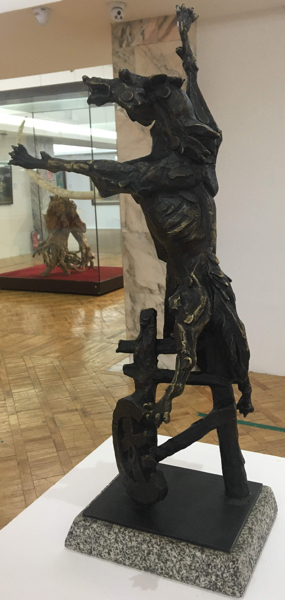 This museum features Mongolia’s modern art, produced since the Mongolian Independence Revolution of 1921. The first piece that really caught my eye was a bronze sculpture called “Scarecrow,” by Davaasambuu Tumennast. The piece looked like a tortured combination of a wolf and a horse. The creature was mounted on a something that resembled part of a fence that also had a broken wheel attached to it. (I’m not really sure what it was.) All four legs were splayed out, with claws extended, and every muscle stood out. The ears were laid back, and teeth bared. Very disturbing, yet also fascinating.
This museum features Mongolia’s modern art, produced since the Mongolian Independence Revolution of 1921. The first piece that really caught my eye was a bronze sculpture called “Scarecrow,” by Davaasambuu Tumennast. The piece looked like a tortured combination of a wolf and a horse. The creature was mounted on a something that resembled part of a fence that also had a broken wheel attached to it. (I’m not really sure what it was.) All four legs were splayed out, with claws extended, and every muscle stood out. The ears were laid back, and teeth bared. Very disturbing, yet also fascinating.
I wandered around the gallery, checking out the other art pieces. There were a few more bronze sculptures that caught my eye, as well as a number of paintings. 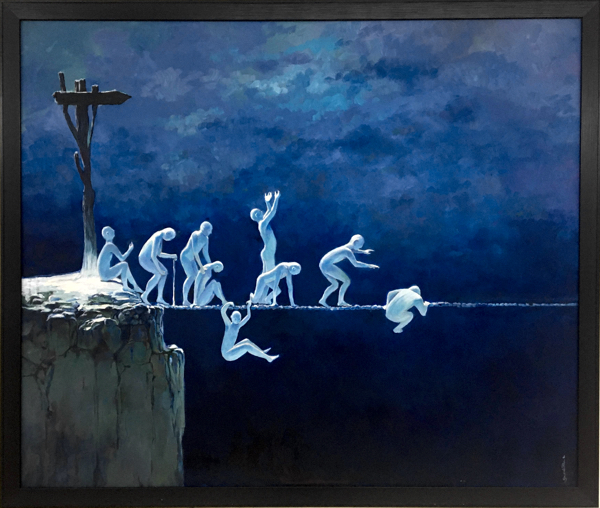 One was a rather disturbing oil on canvas, “The Journey to X” by Erdenetsogt Olonbayar. The piece had nine white human silhouettes walking a tight wire against a beautiful, deep blue sky background. The white and light blue silhouettes stood out starkly against the dark blue background. And, they looked rather tortured to me, or desperate or something. I’m not sure why they were trying to cross the tight wire; it’s a desperate act of someone with nothing left to lose. It was kind of creepy, yet beautiful.
One was a rather disturbing oil on canvas, “The Journey to X” by Erdenetsogt Olonbayar. The piece had nine white human silhouettes walking a tight wire against a beautiful, deep blue sky background. The white and light blue silhouettes stood out starkly against the dark blue background. And, they looked rather tortured to me, or desperate or something. I’m not sure why they were trying to cross the tight wire; it’s a desperate act of someone with nothing left to lose. It was kind of creepy, yet beautiful.
Another oil on canvas, “The First Snow,” by Battsengel Bold drew me, for entirely different reasons. I’ve spent most of my adult life in Alaska. 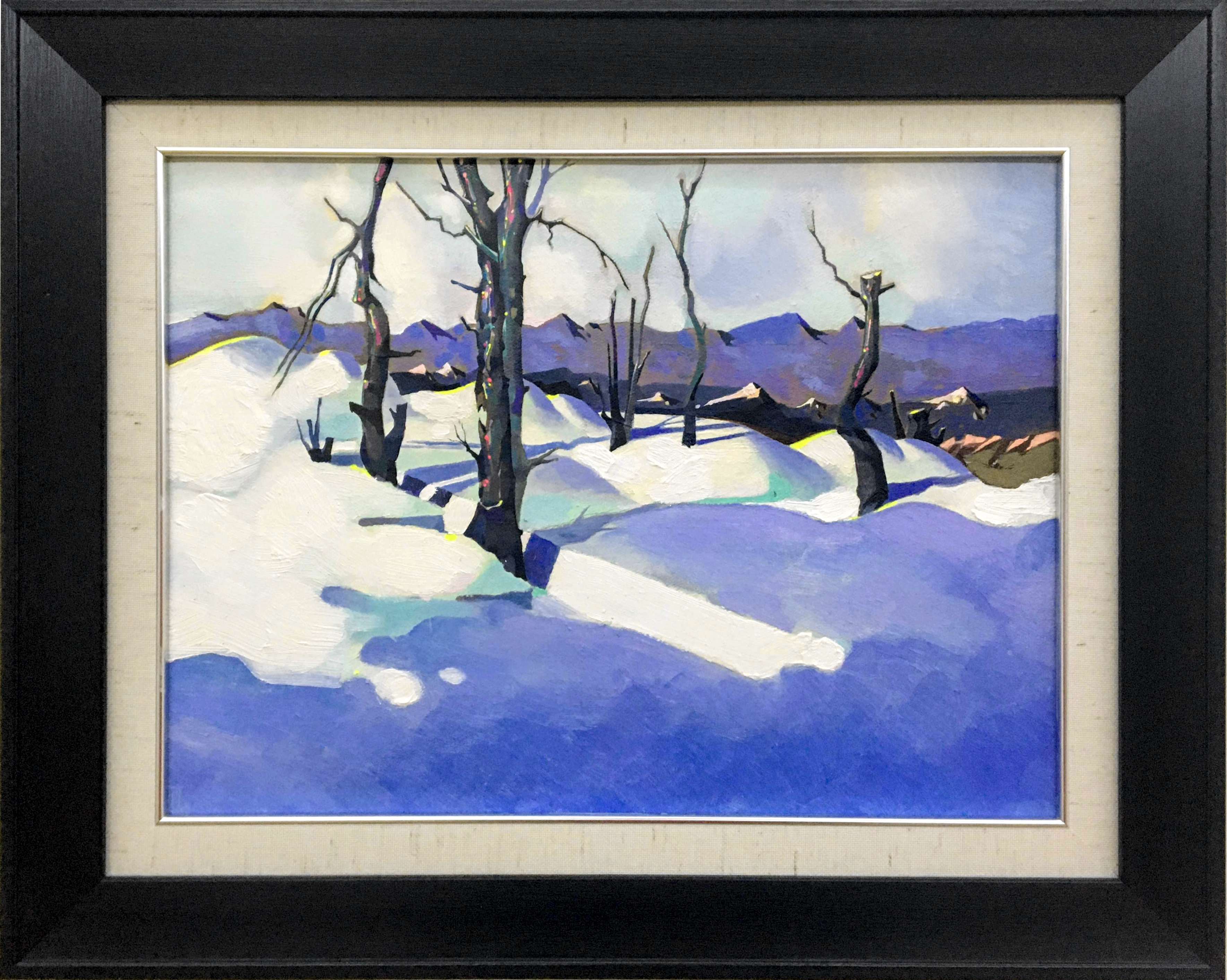 I love snow, and cold doesn’t bother me, which is one of the reasons I was happy to visit the coldest capital city in the world in October. When I look at snow scenes, I remember good times cross-country skiing, snowshoeing, and other happy activities we enjoyed with friends and family. And, spending time afterward warming ourselves around the fireplace, sipping hot chocolate. The majority of paintings I own are snow scenes. They remind me of home and make me feel warm and happy, and this one did, too.
I love snow, and cold doesn’t bother me, which is one of the reasons I was happy to visit the coldest capital city in the world in October. When I look at snow scenes, I remember good times cross-country skiing, snowshoeing, and other happy activities we enjoyed with friends and family. And, spending time afterward warming ourselves around the fireplace, sipping hot chocolate. The majority of paintings I own are snow scenes. They remind me of home and make me feel warm and happy, and this one did, too.
The museum contained art of other mediums, as well. 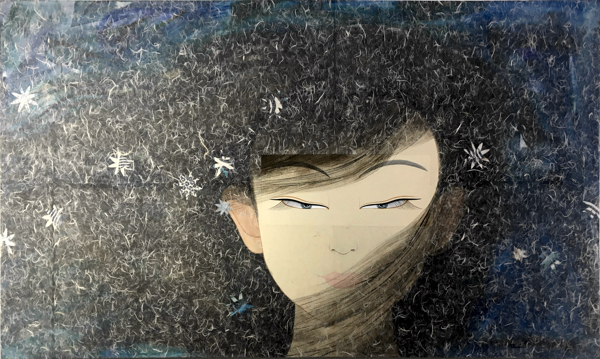 Khongorzul Lkhagvajav’s mixed technique “Murmur” featured a young blue-eyed Mongolian woman with windswept hair and a rather perturbed expression. I don’t think I would want to cross this young woman!
Khongorzul Lkhagvajav’s mixed technique “Murmur” featured a young blue-eyed Mongolian woman with windswept hair and a rather perturbed expression. I don’t think I would want to cross this young woman!
My favorite piece was “Mongolian Great Peace” by Purev Dolgorjav. Not only did I love the bright, happy colors–sky blue, grass green, and a pink shirt–but also the look of trust in the young horse’s face as it rested its head in the arms of the young woman. (Child? Not sure.) It just looks happy and peaceful, with gers surrounded by flocks of sheep resembling clouds, and the blue horse with white cloud spots
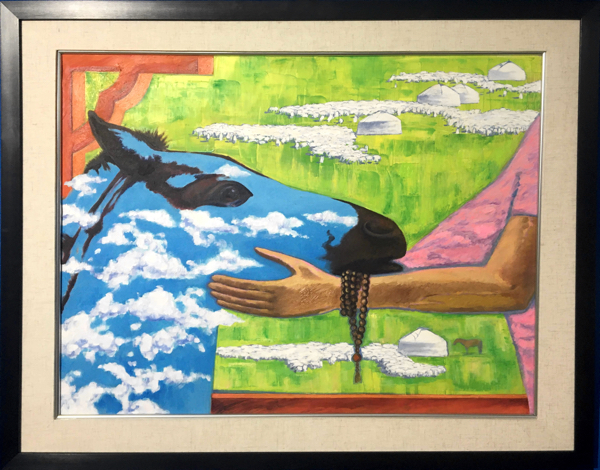 I spent probably about an hour checking out the exhibit. It’s not huge. There were a little more than 100 pieces on display at the time of my visit, not counting the Chinese artist on the lower floor. And, it’s all modern art, so if you’re looking for history, you won’t find it here. Most of the pieces, in fact, were from the past couple of years.
I spent probably about an hour checking out the exhibit. It’s not huge. There were a little more than 100 pieces on display at the time of my visit, not counting the Chinese artist on the lower floor. And, it’s all modern art, so if you’re looking for history, you won’t find it here. Most of the pieces, in fact, were from the past couple of years.
However, it’s a wonderful opportunity to see modern Mongolian art. And, the explanation cards for each piece are in Mongolian and English. At a seventy-five cent admission fee, it’s a bargain! I highly recommend it!